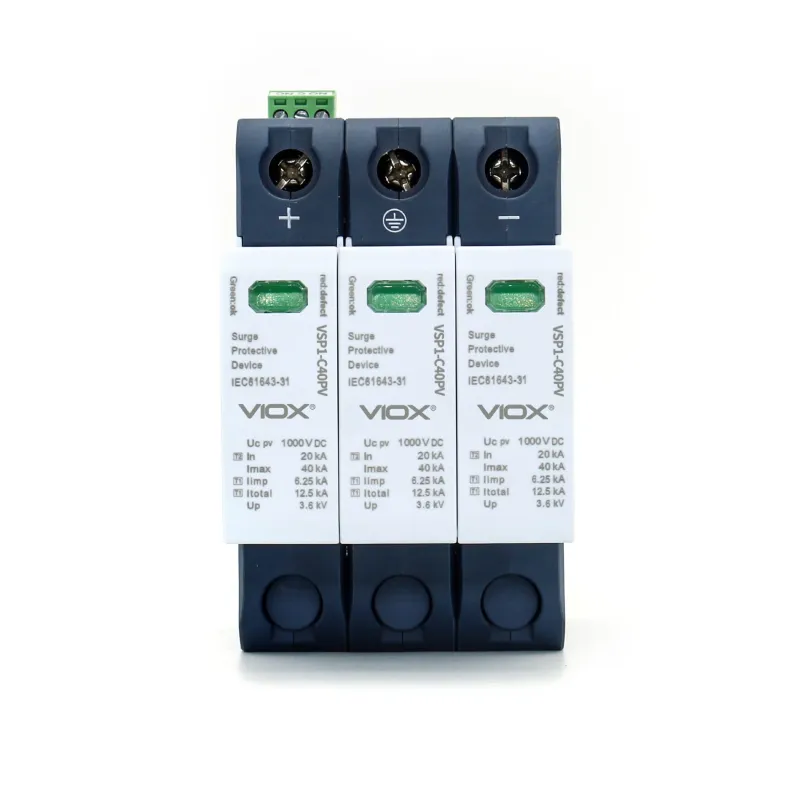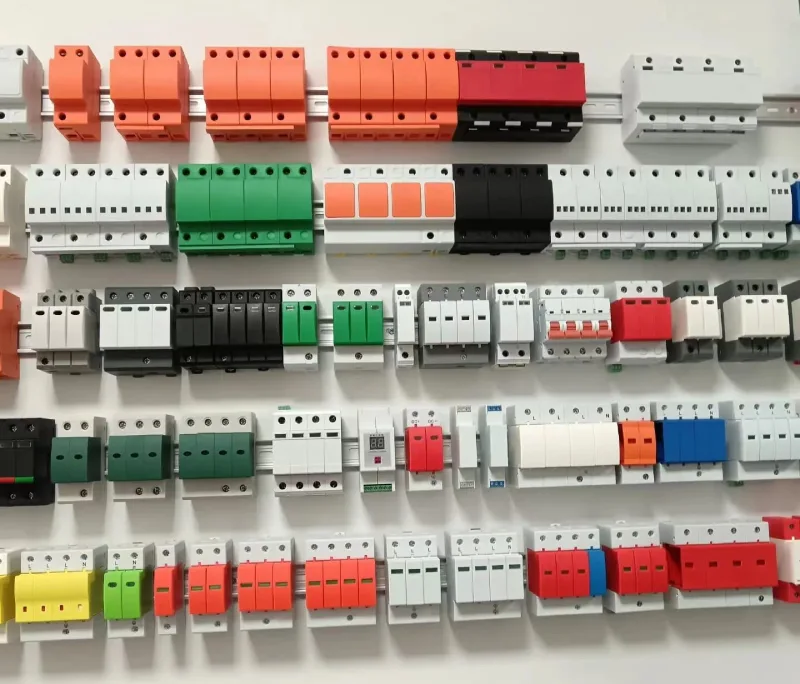Uc und Up sind zwei kritische Spannungsparameter, die bestimmen, wie effektiv ein Überspannungsschutzgerät (SPD) schützt Ihre elektrischen Geräte. Uc steht für die maximale Dauerbetriebsspannung, während Up den Spannungsschutzpegel angibt, der die Überspannung während der Aktivierung begrenzt. Das richtige Verständnis dieser Parameter gewährleistet optimalen Überspannungsschutz und verhindert kostspielige Geräteschäden.
Was bedeuten Uc und Up bei SPD? Wichtige Definitionen

Uc: Maximale Dauerbetriebsspannung
Uc (Maximale Dauerbetriebsspannung) ist die maximale Wechsel- oder Gleichspannung, die kontinuierlich an den SPD angelegt werden kann, ohne dass es zu einer Aktivierung oder Degradation kommt. Dieser Parameter bestimmt, wann der SPD unter normalen Betriebsbedingungen inaktiv bleibt.
Hauptmerkmale von Uc:
- Stellt den maximalen Effektivwert der Wechselspannung dar, der kontinuierlich im SPD-Schutzmodus angewendet werden kann
- Muss die Nennspannung des Systems überschreiten, um einen ordnungsgemäßen Betrieb zu gewährleisten
- Bei zu hoher Wahl kann es vorkommen, dass die SPD bei Spannungsspitzen nicht aktiviert wird.
- Das Überschreiten von Uc führt zur Überhitzung des Überspannungsschutzes, beschleunigt die Alterung und kann zu einer möglichen Beschädigung führen.
Up: Spannungsschutzpegel
Up (Spannungsschutzpegel) ist die maximale Spannung an den Anschlüssen des SPD, wenn dieser aktiv ist. Sie wird erreicht, wenn der durch den SPD fließende Strom dem Nennentladestrom (In) entspricht.
Hauptmerkmale von Up:
- Bei Überspannungsschutzgeräten mit Spannungsschalter ist Up die maximale Entladespannung
- Bei Überspannungsschutzgeräten mit Klemmfunktion stellt Up die Spitzenspannung dar, die während der Entladung an den Anschlüssen auftritt.
- Muss unter der Überspannungsfestigkeit der geschützten Ausrüstung liegen
- Niedrigere Up-Werte bieten besseren Schutz für empfindliche Geräte

SPD Uc und Up Vergleichstabelle
| Parameter | Uc (Maximale Dauerbetriebsspannung) | Up (Spannungsschutzpegel) |
|---|---|---|
| Definition | Maximale Spannung für Dauerbetrieb | Maximale Spannung beim Überspannungsschutz |
| Funktion | Bestimmt die SPD-Aktivierungsschwelle | Begrenzt die Überspannung an Geräten |
| Kriterien für die Auswahl | Muss die Nennspannung des Systems überschreiten | Muss unterhalb der Geräte-Spannungsfestigkeit liegen |
| Typische Werte (230-V-System) | 275 V, 320 V, 385 V | 1,5 kV, 2,5 kV, 4 kV |
| Auswirkungen auf die Sicherheit | Verhindert vorzeitige Aktivierung | Verhindert Geräteschäden |
| Standard-Referenz - | IEC 61643-11 | IEC 61643-11 |

So wählen Sie Uc-Werte für verschiedene Anwendungen aus
Uc-Auswahl für gängige Spannungssysteme
Hier ist eine Tabelle, die die empfohlenen Uc-Werte für verschiedene elektrische Systeme zeigt:
| System Spannung | Mindestens erforderlicher Uc | Empfohlene Uc | Sicherheitsmarge |
|---|---|---|---|
| 220 V einphasig | 255V | 275V | 25% |
| 230 V einphasig | 255V | 275 V bis 320 V | 20-39% |
| 380 V dreiphasig | 320 V | 385 V | 21% |
| 400 V dreiphasig | 460 V | 500V | 25% |
💡 Experten-Tipp: Wählen Sie für 230-V-Systeme einen SPD mit einem Uc-Wert von mindestens 275 V. In vielen Anwendungen werden Uc-Werte von 320 V bis 385 V verwendet, um Spannungsschwankungen und Systemfehler auszugleichen.
Schrittweiser UC-Auswahlprozess
- Systemspannung ermitteln
- Nennbetriebsspannung (Un) ermitteln
- Erdungsanordnung des Systems prüfen (TN, TT, IT)
- Spannungsschwankungen berücksichtigen (typischerweise ±10%)
- Berechnen Sie die Mindestanforderungen für Uc
- Wenn ein einphasiger Erdschluss auftritt, erfahren die übrigen Phasen das √3-fache der normalen Phasenspannung
- Sicherheitsfaktor anwenden: Uc ≥ 1,3 × Un (empfohlen)
- Wählen Sie den entsprechenden Uc-Wert
- Wählen Sie aus Standardwerten: 255 V, 275 V, 320 V, 385 V, 420 V
- Gleichgewicht zwischen angemessener Marge und wirksamem Schutz
⚠️ Sicherheit Warnung: Wird Uc zu hoch gewählt, kann SPD keine Schutzmaßnahmen einleiten und Stoßströme nicht wirksam ableiten.
Up-Auswahlhilfe: Sicherstellung eines angemessenen Geräteschutzes
Up-Anforderungen verstehen
Um einen wirksamen Schutz zu gewährleisten, muss der Spannungsschutzpegel Up niedriger sein als die Bemessungsstoßspannung Uw des zu schützenden Betriebsmittels, mit einem allgemeinen Sicherheitsabstand von mindestens 20% (Up ≤ 0,8 × Uw).
Geräte-Stoßspannungsfestigkeit
| Gerätekategorie | Typische Impulsfestigkeit (Uw) | Erforderlich (Max) |
|---|---|---|
| Empfindliche Elektronik | 1,5 kV | ≤1,2 kV |
| Standard-IT-Ausstattung | 2,5 kV | ≤2,0 kV |
| Industrielle Ausrüstung | 4,0 kV | ≤3,2 kV |
| Schwerindustrie | 6,0 kV | ≤4,8 kV |
Auswahlverfahren
- Ermitteln Sie die Ausrüstungsanforderungen
- Ermitteln Sie die Bemessungsstoßspannung Uw des geschützten Betriebsmittels
- Berücksichtigen Sie die EMV-Störfestigkeit gemäß IEC 61000-4-5
- Sicherheitsmargen anwenden
- Berechnen Sie den maximal zulässigen Up: Up ≤ 0,8 × Uw
- Bei 230/400-V-Installationen sollte die installierte Spannung im Allgemeinen ≤2,5 kV betragen
- Berücksichtigen Sie Installationseffekte
- Berücksichtigen Sie Spannungsabfälle in Anschlusskabeln
- Berücksichtigen Sie die Koordination mit vor- und nachgelagerten SPDs
Gemeinsame Uc- und Up-Werte nach Anwendung
Anwendungen für Wohnzwecke
| Anwendung | Empfohlene Uc | Typisch nach oben | Schutzniveau |
|---|---|---|---|
| Hauptpanel (230 V) | 275V | 1,5–2,5 kV | Typ 2 |
| Unterpanels | 275V | 1,5 kV | Typ 2 |
| Empfindliche Geräte | 275V | ≤1,2 kV | Typ 3 |
Kommerzielle/industrielle Anwendungen
| Anwendung | Empfohlene Uc | Typisch nach oben | Schutzniveau |
|---|---|---|---|
| Hauptverteilung (400 V) | 460 V | 2,5–4 kV | Typ 1+2 |
| Motor Control Centers | 385 V | 2,5 kV | Typ 2 |
| Schutz der IT-Ausrüstung | 275V | 1,5 kV | Typ 3 |
💡 Experten-Tipp: In praktischen Anwendungen werden für Dreiphasensysteme üblicherweise Uc-Werte von 320 V bis 385 V gewählt, um auch bei alterndem SPD eine ausreichende Reserve zu gewährleisten.
Beziehung zwischen Uc- und Up-Werten
Wie sich UC auf die Up-Leistung auswirkt
Der Up-Wert des SPDs hängt mit dem Uc-Wert zusammen – höhere Uc-Werte führen im Allgemeinen zu höheren Up-Werten. Diese Beziehung beeinflusst die Schutzwirkung:
Wichtige Beziehungen:
- Höherer Uc = Höhere Aktivierungsschwelle
- Höherer Uc = Typischerweise höhere Up-Werte
- Höher oben = Reduzierter Schutz für empfindliche Geräte
- Größere Uc-Werte führen zu einer höheren Anlaufspannung und Restspannung
Optimierungsstrategie
- Wählen Sie ein angemessenes Mindest-Uc
- Erfüllen Sie die Systemspannungsanforderungen
- Spannungsschwankungen berücksichtigen
- Vermeiden Sie unnötig hohe Werte, die den Schutz beeinträchtigen
- Überprüfen Sie die Up-Kompatibilität
- Stellen Sie sicher, dass das Gerät einer Spannung standhält, die unter der Spannung liegt
- Koordinierungsanforderungen berücksichtigen
- Berücksichtigen Sie Spannungsabfälle in der Anlage
SPD-Auswahl nach Systemtyp
TN-Systemanforderungen
Für TN-Systeme (TN-C, TN-S, TN-CS), bei denen der Neutralleiter geerdet ist, sind unterschiedliche SPD-Konfigurationen erforderlich:
| System Typ | SPD-Konfiguration | Typische Uc | Anmerkungen |
|---|---|---|---|
| TN-C | 3P (L-PEN-Schutz) | 275 V bis 385 V | Kombinierter Neutralleiter-Erde- |
| TN-S | 3P+N (L-PE, N-PE) | 275 V bis 385 V | Separater Neutralleiter, Erde |
| TN-CS | 3P+N bei Umschaltung | 275 V bis 385 V | Wendepunkt kritisch |
TT-Systemanforderungen
TT-Systeme erfordern aufgrund der Asymmetrie der Erdimpedanz einen Schutz gegen Gleichtakt- und Differenzialüberspannungen.
IT-Systemanforderungen
IT-Systeme verfügen über keine direkte Erdverbindung oder eine hochohmige Erdverbindung, sodass der Betrieb auch bei einzelnen Erdschlüssen fortgesetzt werden kann.

Fehlerbehebung bei häufigen Uc- und Up-Problemen
Problem: SPD wird bei Spannungsspitzen nicht aktiviert
Mögliche Ursachen:
- Uc-Wert für Systembedingungen zu hoch gewählt
- Falsche Beurteilung der Systemerdung
- SPD-Verschlechterung im Laufe der Zeit
Lösungen:
- Systemspannungen inklusive Fehlerzustände neu berechnen
- Wählen Sie einen niedrigeren Uc-Wert innerhalb des sicheren Betriebsbereichs
- Überprüfen Sie den Typ und die Konfiguration des Erdungssystems
Problem: Geräteschaden trotz SPD-Installation
Mögliche Ursachen:
- Der Up-Wert übersteigt die Spannungsfestigkeit des Geräts
- Unzureichende Koordination zwischen den SPD-Ebenen
- Schlechte SPD-Installation oder Erdung
Lösungen:
- Stellen Sie sicher, dass Up ≤ 0,8 × Gerätestoßspannungsfestigkeit beträgt
- Installieren Sie ein koordiniertes SPD-System auf mehreren Ebenen
- Überprüfen Sie die Erdungsverbindungen mit niedrigem Widerstand
Problem: Häufiger SPD-Austausch
Mögliche Ursachen:
- Uc-Wert zu nahe an der Systembetriebsspannung
- Übermäßige vorübergehende Überspannungen
- Umweltzerstörung
Lösungen:
- Erhöhen Sie die Uc-Sicherheitsmarge
- Beheben Sie Probleme mit der Stromqualität im Upstream
- Implementieren Sie einen regelmäßigen Wartungsplan
Sicherheitsanforderungen und Einhaltung von Vorschriften
IEC-Standardanforderungen
IEC 61643-11 legt Anforderungen für SPDs in Niederspannungsverteilungssystemen fest, während IEC 62305-4 sich mit den Anforderungen an Blitzschutzsysteme befasst.
Wichtige Sicherheitsanforderungen:
- Typ 1 SPD mit Iimp ≥12,5kA für Anlagen mit Blitzschutzsystemen
- SPD Typ 2 mit In ≥5 kA für Standard-Wechselstrominstallationen
- Richtige Koordination zwischen den Schutzstufen
Sicherheitshinweise zur Installation
⚠️ Kritische Sicherheitspunkte:
- Die Installation muss von zertifizierten Elektrikern durchgeführt werden
- Eine ordnungsgemäße Erdung ist für den SPD-Betrieb unerlässlich
- Regelmäßige Inspektion und Wartung erforderlich
- SPDs sollten über Funktionen zur Fehleranzeige verfügen
Experten-Auswahl-Tipps
Professionelle Empfehlungen
- Wählen Sie immer zertifizierte SPDs
- Wählen Sie SPDs mit UL- oder IEC-Zertifizierung von renommierten Prüfeinrichtungen
- Überprüfen Sie die Einhaltung der örtlichen Elektrovorschriften
- Berücksichtigen Sie die langfristige Leistung
- Wählen Sie Uc-Werte mit ausreichender Reserve, um die Alterung zu berücksichtigen
- Wählen Sie höhere In-Werte für eine längere SPD-Lebensdauer
- Plan zur Koordination
- Mehrere SPD-Geräte müssen gemäß Vorschrift 534.4.4.5 koordiniert werden
- Berücksichtigen Sie die Energiekoordination zwischen den Schutzstufen
- Berücksichtigen Sie zukünftige Änderungen
- Auslegung für mögliche Änderungen der Systemspannung
- Berücksichtigen Sie Geräte-Upgrades und Empfindlichkeitsänderungen
💡 Experten-Tipp: Die Auswahl höherer Stoßstromwerte bietet nicht immer einen besseren Schutz, sorgt aber für eine längere Lebensdauer des SPD.
Häufig Gestellte Fragen
Was passiert, wenn Uc für mein System zu niedrig ist?
Liegt Uc unter der Systembetriebsspannung, wird der Überspannungsableiter dauerhaft aktiviert, was zu einem sofortigen Ausfall und potenziellen Sicherheitsrisiken führen kann. Stellen Sie immer sicher, dass Uc die maximal erwartete Systemspannung überschreitet.
Kann ich ein SPD mit einer höheren Up-Bewertung als meiner Gerätebewertung verwenden?
Nein, der Up-Wert muss niedriger sein als die Stoßspannungsfestigkeit Ihres Geräts mit einem Sicherheitsabstand von mindestens 20% (Up ≤ 0,8 × Uw). Höhere Up-Werte können dazu führen, dass schädliche Spannungen Ihr Gerät erreichen.
Wie bestimme ich die Stoßspannungsfestigkeit meiner Ausrüstung?
Überprüfen Sie die Gerätespezifikationen auf Nennstoßspannung (Uw) oder Überspannungskategorie. Die meisten empfindlichen Geräte in 230/400-V-Installationen sollten gemäß Überspannungskategorie II (2,5 kV) geschützt sein.
Sollte ich für maximale Sicherheit den höchsten verfügbaren Uc-Wert wählen?
Nein, höhere Uc-Werte sind nicht immer besser. Höhere Uc-Werte führen zu einer höheren Anlaufspannung und Restspannung, was die Schutzwirkung beeinträchtigen kann. Wählen Sie den optimalen Uc-Wert entsprechend Ihren Systemanforderungen.
Wie oft sollten SPDs überprüft werden?
Regelmäßige Inspektionen sind unerlässlich. SPDs mit nicht funktionierenden Anzeigen müssen sofort ausgetauscht werden. Planen Sie jährliche Inspektionen oder Inspektionen nach erheblichen Überspannungsereignissen ein.
Was ist der Unterschied zwischen SPDs vom Typ 1, Typ 2 und Typ 3?
SPDs vom Typ 1 fangen direkte Blitzeinschläge ab (10/350 µs), SPDs vom Typ 2 schützen die Hauptinstallation (8/20 µs) und SPDs vom Typ 3 schützen einzelne Geräte in der Nähe von Lasten.
Fazit: Die richtige Wahl treffen
Das Verständnis der Uc- und Up-Parameter ist für einen effektiven Überspannungsschutz unerlässlich. Richtig gewählte Uc-Werte stellen sicher, dass SPDs bei Überspannungen ordnungsgemäß aktiviert werden, während korrekte Up-Werte einen ausreichenden Geräteschutz gewährleisten.
Wichtige Erkenntnisse für eine optimale Auswahl:
- Wählen Sie Uc mit ausreichender Sicherheitsmarge über der Systemspannung
- Stellen Sie sicher, dass Up unterhalb der Widerstandsfähigkeit des Geräts bleibt
- Berücksichtigen Sie die Erdungsanordnung und Fehlerbedingungen des Systems
- Implementieren Sie koordinierten Schutz auf mehreren Ebenen
- Priorisieren Sie zertifizierte SPDs mit ordnungsgemäßer Installation
Bei komplexen Installationen oder kritischen Anwendungen sollten Sie sich an qualifizierte Elektroingenieure wenden, um die optimale SPD-Auswahl und den optimalen Systemschutz sicherzustellen. Die Investition in einen geeigneten Überspannungsschutz übersteigt die Kosten für den Austausch beschädigter Geräte und Systemausfallzeiten bei weitem.
Related
Was ist ein Überspannungsschutzgerät (SPD)
So wählen Sie das richtige SPD für Ihre Solarstromanlage


